INTERNATIONAL
STANDARD
ISO
15118-1
First edition
2013-04-15
Part 1:
Road vehicles — Vehicle to grid
communication interface —
General information and use-case
definition
Véhicules routiers — Interface de communication entre véhicule et
réseau électrique —
Partie 1: Informations générales et définition de cas d’utilisation
Reference number
ISO 15118-1:2013(E)
© ISO 2013
Copyright International Organization for Standardization Provided by IHS under license with ISO Not for ResaleNo reproduction or networking permitted without license from IHS--`,,```,,,,````-`-`,,`,,`,`,,`---�
ISO 15118-1:2013(E)
COPYRIGHT PROTECTED DOCUMENT
© ISO 2013
All rights reserved. Unless otherwise specified, no part of this publication may be reproduced or utilized otherwise in any form
or by any means, electronic or mechanical, including photocopying, or posting on the internet or an intranet, without prior
written permission. Permission can be requested from either ISO at the address below or ISO’s member body in the country of
the requester.
ISO copyright office
Case postale 56 • CH-1211 Geneva 20
Tel. + 41 22 749 01 11
Fax + 41 22 749 09 47
E-mail copyright@iso.org
Web www.iso.org
Published in Switzerland
ii
© ISO 2013 – All rights reserved
Copyright International Organization for Standardization Provided by IHS under license with ISO Not for ResaleNo reproduction or networking permitted without license from IHS--`,,```,,,,````-`-`,,`,,`,`,,`---�
ISO 15118-1:2013(E)
1
2
3
4
5
Contents
Page
Foreword ........................................................................................................................................................................................................................................iv
Introduction ..................................................................................................................................................................................................................................v
Scope .................................................................................................................................................................................................................................1
Normative references ......................................................................................................................................................................................1
Terms and definitions .....................................................................................................................................................................................2
Symbols and abbreviated terms ...........................................................................................................................................................9
Requirements .......................................................................................................................................................................................................10
5.1
Communication concept ..............................................................................................................................................................10
General considerations .................................................................................................................................................................11
5.2
User-specific requirements .......................................................................................................................................................11
5.3
OEM-specific requirements.......................................................................................................................................................12
5.4
5.5
Utility-specific requirements ...................................................................................................................................................13
Actors.............................................................................................................................................................................................................................14
General ........................................................................................................................................................................................................14
6.1
Use Case Elements ............................................................................................................................................................................................15
General ........................................................................................................................................................................................................15
7.1
Start of charging process [A] ..................................................................................................................................................17
7.2
7.3
Communication set-up [B] .........................................................................................................................................................20
7.4
Certificate handling [C] .................................................................................................................................................................20
7.5
Identification and Authorization [D].................................................................................................................................23
Target setting and charging scheduling [E] .................................................................................................................29
7.6
Charging controlling and re-scheduling [F] ................................................................................................................36
7.7
7.8
Value Added Services [G] ............................................................................................................................................................42
7.9
End of charging process [H]......................................................................................................................................................43
Annex A (informative) Charging infrastructure architecture ..................................................................................................45
Annex B (informative) Security ...............................................................................................................................................................................55
Annex C (informative) Examples of charging scenarios derived from the use case elements ...............60
Bibliography .............................................................................................................................................................................................................................65
6
7
© ISO 2013 – All rights reserved
iii
Copyright International Organization for Standardization Provided by IHS under license with ISO Not for ResaleNo reproduction or networking permitted without license from IHS--`,,```,,,,````-`-`,,`,,`,`,,`---�
ISO 15118-1:2013(E)
Foreword
ISO (the International Organization for Standardization) is a worldwide federation of national standards
bodies (ISO member bodies). The work of preparing International Standards is normally carried out
through ISO technical committees. Each member body interested in a subject for which a technical
committee has been established has the right to be represented on that committee. International
organizations, governmental and non-governmental, in liaison with ISO, also take part in the work.
ISO collaborates closely with the International Electrotechnical Commission (IEC) on all matters of
electrotechnical standardization.
The procedures used to develop this document and those intended for its further maintenance are
described in the ISO/IEC Directives, Part 1. In particular the different approval criteria needed for the
different types of ISO documents should be noted. This document was drafted in accordance with the
editorial rules of the ISO/IEC Directives, Part 2. www.iso.org/directives
Attention is drawn to the possibility that some of the elements of this document may be the subject of
patent rights. ISO shall not be held responsible for identifying any or all such patent rights. Details of
any patent rights identified during the development of the document will be in the Introduction and/or
on the ISO list of patent declarations received. www.iso.org/patents
Any trade name used in this document is information given for the convenience of users and does not
constitute an endorsement.
The committee responsible for this document is ISO/TC 22, Road vehicles, Subcommittee SC 3, Electrical
and electronic equipment.
ISO 15118-1 was developed in cooperation with IEC TC 69, Electric road vehicles and electric industrial trucks.
ISO 15118 consists of the following parts, under the general title Road vehicles — Vehicle to grid
communication interface:
— Part 1: General information and use-case definition
— Part 2: Network and application protocol requirements
— Part 3: Physical and data link layer requirements
The following parts are under preparation:
— Part 4: Network and application protocol conformance test
— Part 5: Physical layer and data link layer conformance test
iv
© ISO 2013 – All rights reserved
Copyright International Organization for Standardization Provided by IHS under license with ISO Not for ResaleNo reproduction or networking permitted without license from IHS--`,,```,,,,````-`-`,,`,,`,`,,`---�
ISO 15118-1:2013(E)
Introduction
The pending energy crisis and the necessity to reduce greenhouse gas emissions have led vehicle
manufacturers to make a very significant effort to reduce the energy consumption of their vehicles.
They are presently developing vehicles partly or completely propelled by electric energy. Those vehicles
will reduce the dependency on oil, improve global energy efficiency and reduce the total CO2 emissions
for road transportation if the electricity is produced from renewable sources. To charge the batteries of
such vehicles, specific charging infrastructure is required.
Much of the standardization work on dimensional and electrical specifications of the charging
infrastructure and the vehicle interface is already treated in the relevant ISO or IEC groups. However,
the question of information transfer between the vehicle, the local installation and the grid has not been
treated sufficiently.
Such communication is beneficial for the optimization of energy resources and energy production systems
as vehicles can recharge at the most economic or most energy-efficient instants. It is also required to
develop efficient and convenient payment systems in order to cover the resulting micro-payments. The
necessary communication channel may serve in the future to contribute to the stabilization of the electrical
grid as well as to support additional information services required to operate electric vehicles efficiently.
© ISO 2013 – All rights reserved
v
Copyright International Organization for Standardization Provided by IHS under license with ISO Not for ResaleNo reproduction or networking permitted without license from IHS--`,,```,,,,````-`-`,,`,,`,`,,`---�
Copyright International Organization for Standardization Provided by IHS under license with ISO Not for ResaleNo reproduction or networking permitted without license from IHS--`,,```,,,,````-`-`,,`,,`,`,,`---�
INTERNATIONAL STANDARD
ISO 15118-1:2013(E)
1 Scope
General information and use-case definition
Road vehicles — Vehicle to grid communication interface —
Part 1:
ISO 15118 specifies the communication between Electric Vehicles (EV), including Battery Electric
Vehicles and Plug-In Hybrid Electric Vehicles, and the Electric Vehicle Supply Equipment (EVSE). As the
communication parts of this generic equipment are the Electric Vehicle Communication Controller (EVCC)
and the Supply Equipment Communication Controller (SECC), ISO 15118 describes the communication
between these components. Although ISO 15118 is oriented to the charging of electric road vehicles, it is
open for other vehicles as well.
This part of ISO 15118 specifies terms and definitions, general requirements and use cases as the basis
for the other parts of ISO 15118. It provides a general overview and a common understanding of aspects
influencing the charge process, payment and load levelling.
ISO 15118 does not specify the vehicle internal communication between battery and charging
equipment and the communication of the SECC to other actors and equipment (beside some dedicated
message elements related to the charging). All connections beyond the SECC, and the method of message
exchanging are considered to be out of the scope as specific use cases.
NOTE 1
Electric road vehicles specifically are vehicles in categories M (used for carriage of passengers) and
N (used for carriage of goods) (compare ECE/TR ANS/WP.29/78 ev.2). This does not prevent vehicles in other
categories from adopting ISO 15118 as well.
NOTE 2
This part of ISO 15118 is destined to orientate the message set of ISO 15118-2. The absence of any particular
use case in this part of ISO 15118 does not imply that it shall not put into practice, with the required messages.
NOTE 3
This part of ISO 15118 and ISO 15118-2 are designed to work independent of data transfer medium
used. However, this series of documents are made for fitting the specified data link layers in the corresponding
documents in this series.
The following documents, in whole or in part, are normatively referenced in this document and are
indispensable for its application. For dated references, only the edition cited applies. For undated
references, the latest edition of the referenced document (including any amendments) applies.
IEC 60050, International electrotechnical vocabulary
IEC 61851-1, Electric vehicle conductive charging system — Part 1: General requirements
ISO/TR 8713, Electrically propelled road vehicles — Vocabulary
ISO 15118-2, Road vehicles — Vehicle to grid communication interface — Part 2: Network and application
ISO 15118-3, Road Vehicles — Vehicle to grid communication interface — Part 3: Physical and data link
2 Normative references
protocol requirements
layer requirements
© ISO 2013 – All rights reserved
1
Copyright International Organization for Standardization Provided by IHS under license with ISO Not for ResaleNo reproduction or networking permitted without license from IHS--`,,```,,,,````-`-`,,`,,`,`,,`---�
ISO 15118-1:2013(E)
3 Terms and definitions
3.1
actor
3.7
certificate
3.3
authentication
3.4
authorization
3.5
basic signalling
3.6
Battery Management System
3.2
amount of energy for charging
For the purposes of this document, the terms and definitions given in ISO/TR 8713 and the following apply.
entity which characterizes a role played by a user or any other system that interacts with the subject
energy required by the EV until the departure time has been reached or the battery’s SOC is at 100 %
Note 1 to entry: This might include the amount of energy the EV consumes for other vehicle features than solely
charging the battery.
procedure between EVCC and SECC or between USER and EVSE or SA, to prove that the provided
information (see identification) is either correct, valid, or it belongs to the EVCC, the USER or the SECC
procedure for EVSE to verify if EV is allowed to be charged
physical signalling according to the pilot function provided by IEC 61851-1, Annex A
BMSelectronic device that controls or manages the electric and thermal functions of the battery system and
that provides communication between the battery system and other vehicle controllers
electronic document which uses a digital signature to bind a public key with an identity
Note 1 to entry: ISO 15118 describes several certificates covering different purposes (e.g. Contract Certificate
including the contract ID and OEM Provisioning Certificates)
power converter that performs the necessary functions for charging a battery
function that confirms the maximum charge current which is allowed to be drawn from EVSE based on
charging schedule
Note 1 to entry: Actual charge current to the battery should be controlled by BMS. It is not in scope of ISO 15118.
combination of use case elements to fulfil a specific charging use case
scheme which contains the power limits for charging the EV for a specific time
Note 1 to entry: The EV should apply the negotiated limits as close as possible, to allow power balancing for the DSO
© ISO 2013 – All rights reserved
3.10
charging scenario
3.11
charging schedule
3.8
charger
3.9
charging control
2
Copyright International Organization for Standardization Provided by IHS under license with ISO Not for ResaleNo reproduction or networking permitted without license from IHS--`,,```,,,,````-`-`,,`,,`,`,,`---�
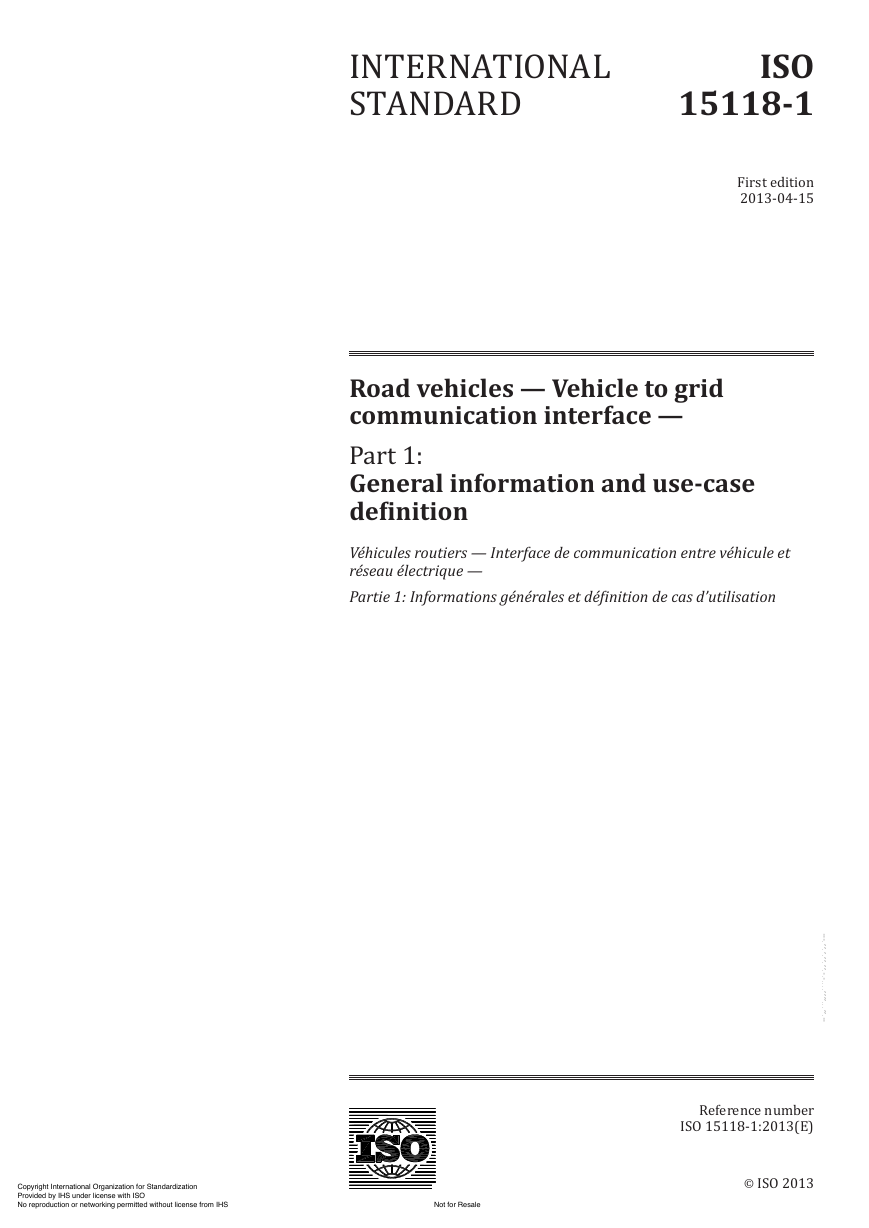
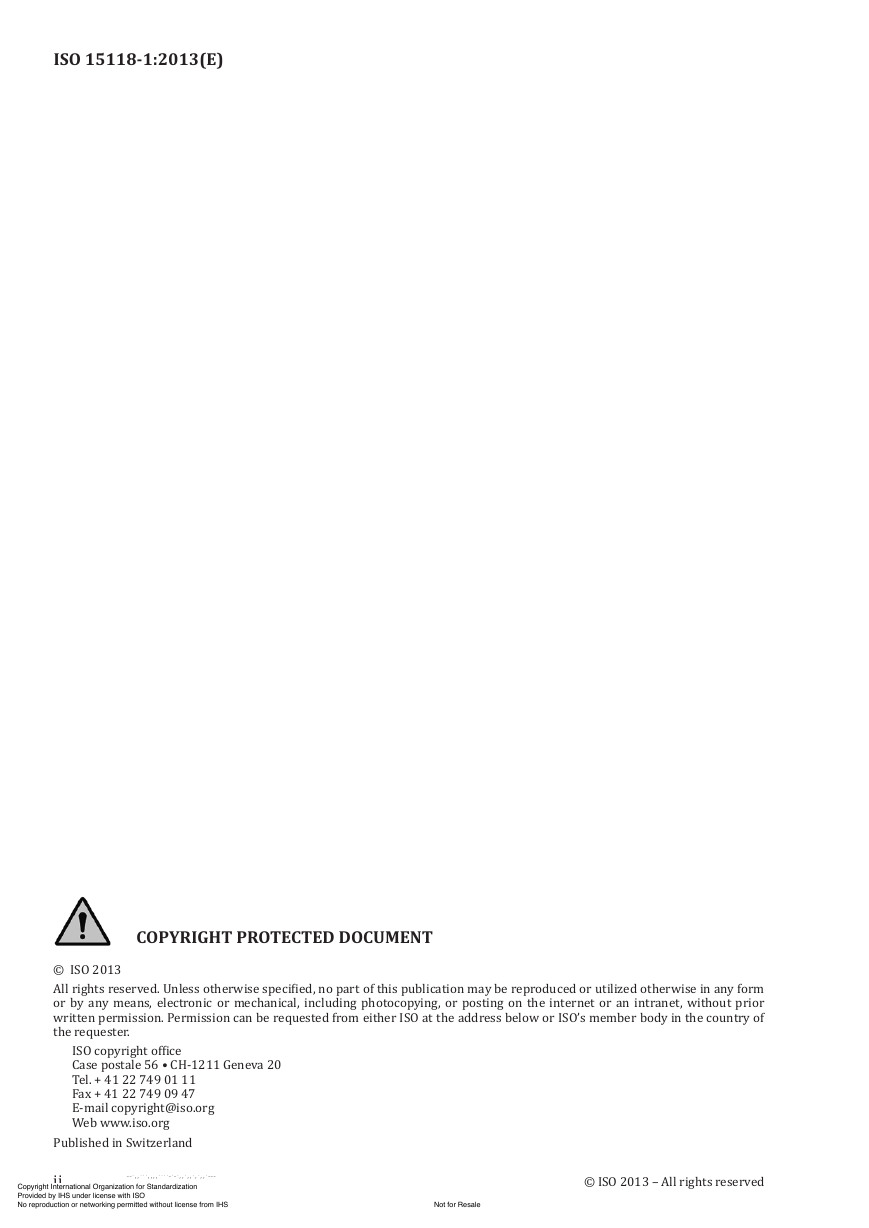
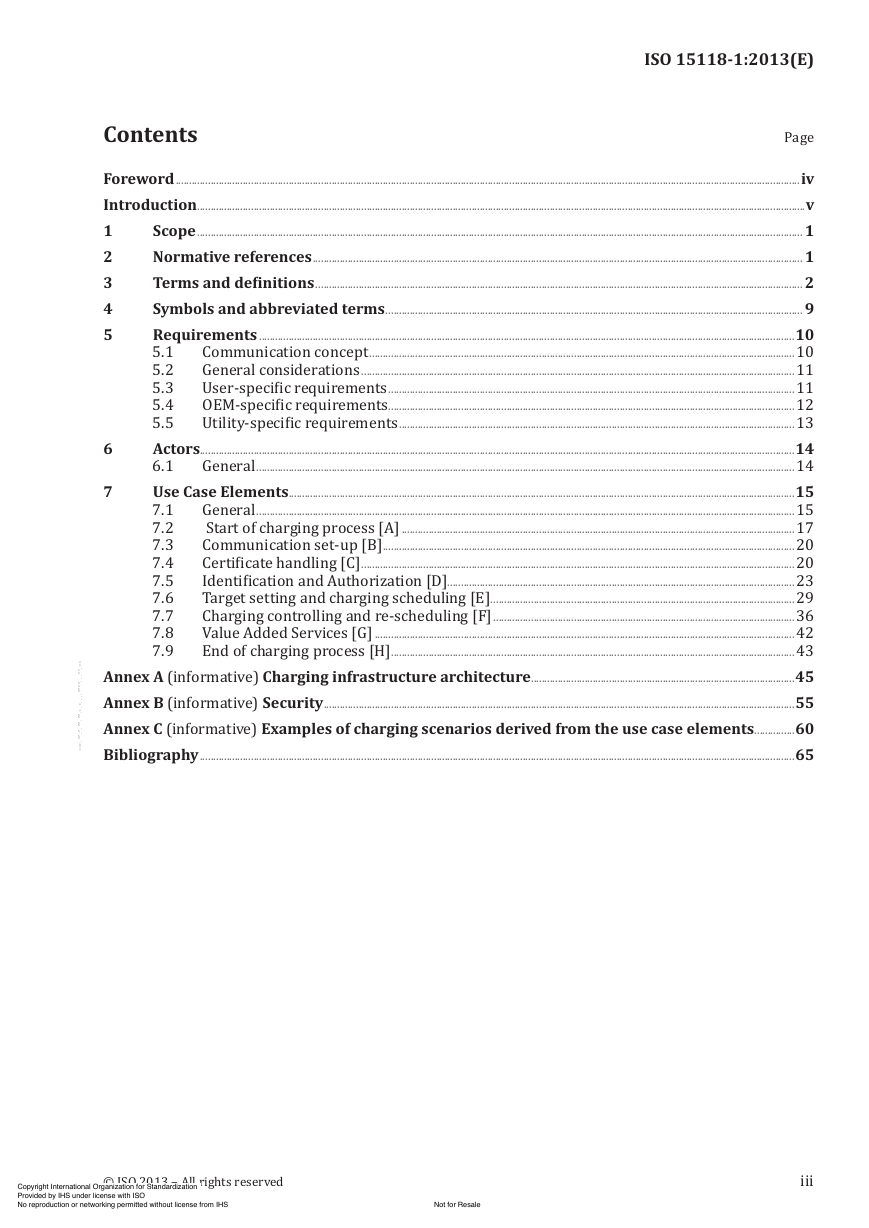

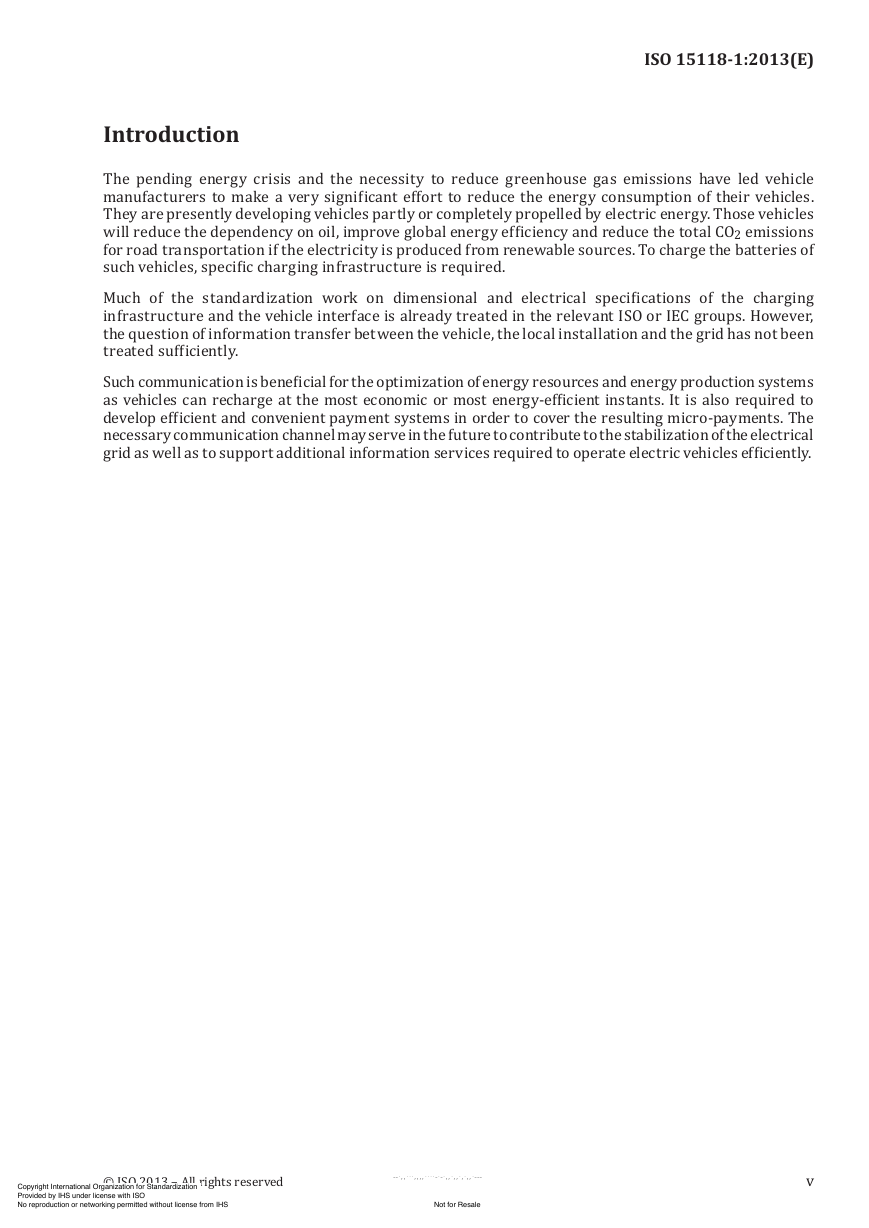

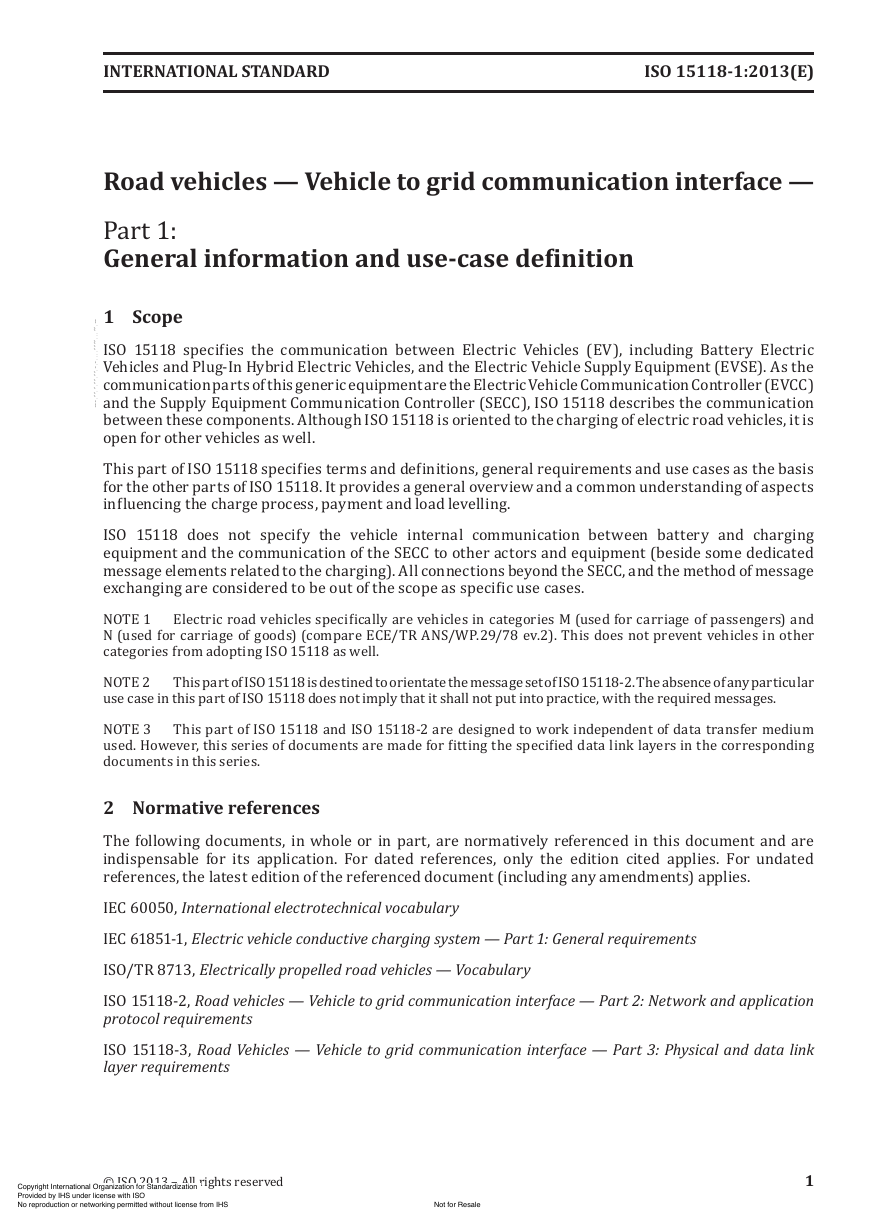
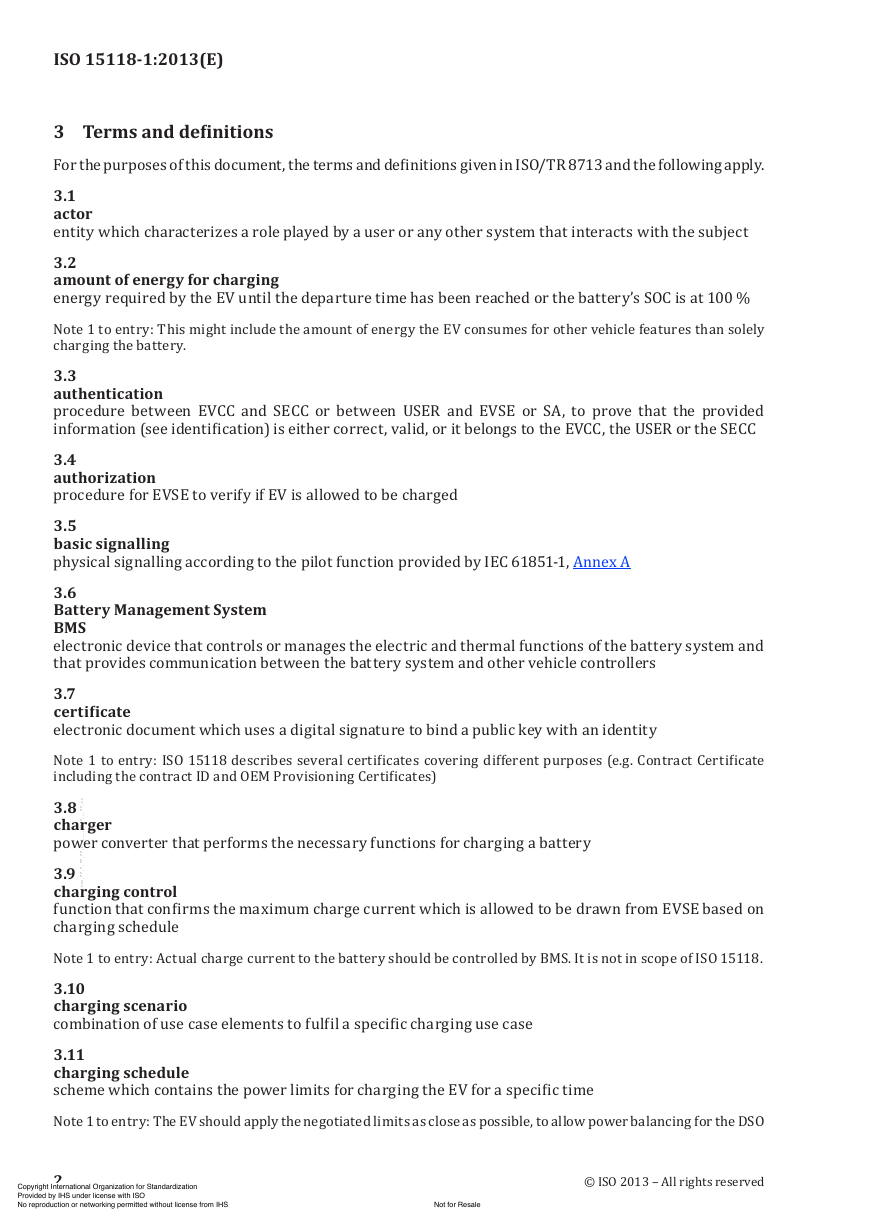








 2023年江西萍乡中考道德与法治真题及答案.doc
2023年江西萍乡中考道德与法治真题及答案.doc 2012年重庆南川中考生物真题及答案.doc
2012年重庆南川中考生物真题及答案.doc 2013年江西师范大学地理学综合及文艺理论基础考研真题.doc
2013年江西师范大学地理学综合及文艺理论基础考研真题.doc 2020年四川甘孜小升初语文真题及答案I卷.doc
2020年四川甘孜小升初语文真题及答案I卷.doc 2020年注册岩土工程师专业基础考试真题及答案.doc
2020年注册岩土工程师专业基础考试真题及答案.doc 2023-2024学年福建省厦门市九年级上学期数学月考试题及答案.doc
2023-2024学年福建省厦门市九年级上学期数学月考试题及答案.doc 2021-2022学年辽宁省沈阳市大东区九年级上学期语文期末试题及答案.doc
2021-2022学年辽宁省沈阳市大东区九年级上学期语文期末试题及答案.doc 2022-2023学年北京东城区初三第一学期物理期末试卷及答案.doc
2022-2023学年北京东城区初三第一学期物理期末试卷及答案.doc 2018上半年江西教师资格初中地理学科知识与教学能力真题及答案.doc
2018上半年江西教师资格初中地理学科知识与教学能力真题及答案.doc 2012年河北国家公务员申论考试真题及答案-省级.doc
2012年河北国家公务员申论考试真题及答案-省级.doc 2020-2021学年江苏省扬州市江都区邵樊片九年级上学期数学第一次质量检测试题及答案.doc
2020-2021学年江苏省扬州市江都区邵樊片九年级上学期数学第一次质量检测试题及答案.doc 2022下半年黑龙江教师资格证中学综合素质真题及答案.doc
2022下半年黑龙江教师资格证中学综合素质真题及答案.doc